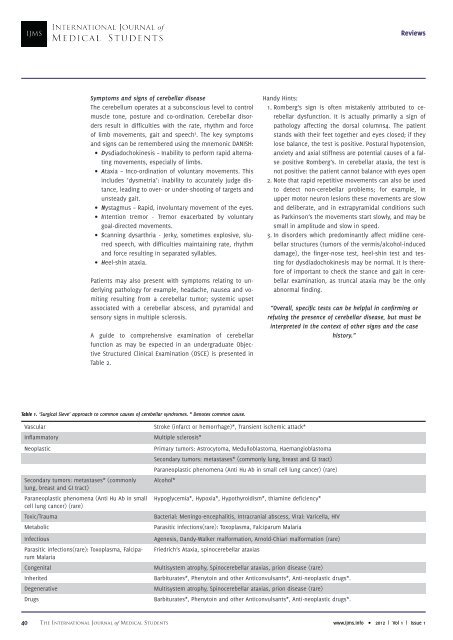Year 2012 - Volume 1 - Issue 1 - IJMS
Year 2012 - Volume 1 - Issue 1 - IJMS
Year 2012 - Volume 1 - Issue 1 - IJMS
You also want an ePaper? Increase the reach of your titles
YUMPU automatically turns print PDFs into web optimized ePapers that Google loves.
40<br />
<strong>IJMS</strong><br />
International Journal of<br />
Medical Students<br />
Symptoms and signs of cerebellar disease<br />
The cerebellum operates at a subconscious level to control<br />
muscle tone, posture and co-ordination. Cerebellar disorders<br />
result in difficulties with the rate, rhythm and force<br />
of limb movements, gait and speech 3 . The key symptoms<br />
and signs can be remembered using the mnemonic DANISH:<br />
• Dysdiadochokinesis – Inability to perform rapid alternating<br />
movements, especially of limbs.<br />
• Ataxia – Inco-ordination of voluntary movements. This<br />
includes ‘dysmetria’: inability to accurately judge distance,<br />
leading to over- or under-shooting of targets and<br />
unsteady gait.<br />
• Nystagmus – Rapid, involuntary movement of the eyes.<br />
• Intention tremor - Tremor exacerbated by voluntary<br />
goal-directed movements.<br />
• Scanning dysarthria - Jerky, sometimes explosive, slurred<br />
speech, with difficulties maintaining rate, rhythm<br />
and force resulting in separated syllables.<br />
• Heel-shin ataxia.<br />
Patients may also present with symptoms relating to underlying<br />
pathology for example, headache, nausea and vomiting<br />
resulting from a cerebellar tumor; systemic upset<br />
associated with a cerebellar abscess, and pyramidal and<br />
sensory signs in multiple sclerosis.<br />
A guide to comprehensive examination of cerebellar<br />
function as may be expected in an undergraduate Objective<br />
Structured Clinical Examination (OSCE) is presented in<br />
Table 2.<br />
Table 1. ‘Surgical Sieve’ approach to common causes of cerebellar syndromes. * Denotes common cause.<br />
Vascular Stroke (infarct or hemorrhage)*, Transient ischemic attack*<br />
Inflammatory Multiple sclerosis*<br />
Neoplastic Primary tumors: Astrocytoma, Medulloblastoma, Haemangioblastoma<br />
Secondary tumors: metastases* (commonly<br />
lung, breast and GI tract)<br />
Paraneoplastic phenomena (Anti Hu Ab in small<br />
cell lung cancer) (rare)<br />
Secondary tumors: metastases* (commonly lung, breast and GI tract)<br />
Paraneoplastic phenomena (Anti Hu Ab in small cell lung cancer) (rare)<br />
Alcohol*<br />
Hypoglycemia*, Hypoxia*, Hypothyroidism*, thiamine deficiency*<br />
Toxic/Trauma Bacterial: Meningo-encephalitis, Intracranial abscess, Viral: Varicella, HIV<br />
Metabolic Parasitic infections(rare): Toxoplasma, Falciparum Malaria<br />
Infectious Agenesis, Dandy-Walker malformation, Arnold-Chiari malformation (rare)<br />
Parasitic infections(rare): Toxoplasma, Falciparum<br />
Malaria<br />
Friedrich’s Ataxia, spinocerebellar ataxias<br />
Congenital Multisystem atrophy, Spinocerebellar ataxias, prion disease (rare)<br />
Reviews<br />
Handy Hints:<br />
1. Romberg’s sign is often mistakenly attributed to cerebellar<br />
dysfunction. It is actually primarily a sign of<br />
pathology affecting the dorsal columns4. The patient<br />
stands with their feet together and eyes closed; if they<br />
lose balance, the test is positive. Postural hypotension,<br />
anxiety and axial stiffness are potential causes of a false<br />
positive Romberg’s. In cerebellar ataxia, the test is<br />
not positive: the patient cannot balance with eyes open<br />
2. Note that rapid repetitive movements can also be used<br />
to detect non-cerebellar problems; for example, in<br />
upper motor neuron lesions these movements are slow<br />
and deliberate, and in extrapyramidal conditions such<br />
as Parkinson’s the movements start slowly, and may be<br />
small in amplitude and slow in speed.<br />
3. In disorders which predominantly affect midline cerebellar<br />
structures (tumors of the vermis/alcohol-induced<br />
damage), the finger-nose test, heel-shin test and testing<br />
for dysdiadochokinesis may be normal. It is therefore<br />
of important to check the stance and gait in cerebellar<br />
examination, as truncal ataxia may be the only<br />
abnormal finding.<br />
“Overall, specific tests can be helpful in confirming or<br />
refuting the presence of cerebellar disease, but must be<br />
interpreted in the context of other signs and the case<br />
history.”<br />
Inherited Barbiturates*, Phenytoin and other Anticonvulsants*, Anti-neoplastic drugs*.<br />
Degenerative Multisystem atrophy, Spinocerebellar ataxias, prion disease (rare)<br />
Drugs Barbiturates*, Phenytoin and other Anticonvulsants*, Anti-neoplastic drugs*.<br />
The International Journal of Medical Students www.ijms.info • <strong>2012</strong> | Vol 1 | <strong>Issue</strong> 1


